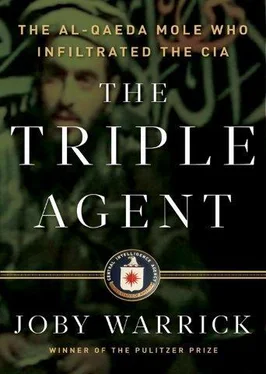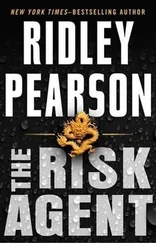The next hurdle was getting Balawi in and out of the base without compromising his identity. The chief worry, Matthews knew, was the front gate. There could well be Taliban spies among the Afghan soldiers who manned the outer perimeter, and there almost certainly were some among the local civilians who congregated near the gate to apply for work or seek medical care. At Khost, the CIA had always whisked key informants through the main gate without an ID check so their faces would not be seen. An agent as valuable as Balawi would merit even greater precautions.
Finally, there was the meeting itself. Matthews envisioned an all-hands event. Langley needed to know whether Balawi was real or just a talented con artist, so Matthews would call in her experienced case officers to ask questions and study the agent’s body language. Balawi presumably would know details about a great many terrorist operatives other than Zawahiri, so Matthews needed her best al-Qaeda and Taliban experts with her to take advantage of what might well be the agency’s only chance to interview an al-Qaeda double agent. Most important, if the Jordanian were indeed ready to lead the CIA to Zawahiri, he would need special training and perhaps tools. Technicians would show him how to send secret signals to communicate where and when a strike should take place. The agency had numerous gadgets in its tool kit, including a cell phone that could take and send digital photographs that appear ordinary in every way, except that they are encoded with hidden geographic coordinates. The image, once deciphered, would reveal exactly where on earth it was taken.
There was another critical ingredient, and Matthews gave it considerable thought. The CIA was asking Balawi, more than ever, to risk his very life. The agency would have to do everything it could to keep him happy and motivated. Matthews had listened carefully to the Jordanian intelligence officer, Ali bin Zeid, when he described the informant’s moodiness and fragile ego. Balawi came from a culture that demanded social courtesies in business dealings, and after ten months of dangerous work in Pakistan, he felt entitled to some respect, bin Zeid explained. Matthews would make certain that he got it. There would be Arab-style formality, including an extensive reception with introductions, handshakes, and exchanged pleasantries. Balawi would be offered medical care and food. And as a personal gesture intended to cement the friendship, he would be surprised with a birthday cake. It was a sheet cake with chocolate frosting, made by the base’s own chefs.
“He has to be made to feel welcomed,” she repeatedly told her subordinates.
Matthews reviewed what she had written. Including the security detail and Balawi himself, there would be sixteen people at the meeting, and possibly more. It was an unusual plan, but then, Balawi was a highly unusual agent. What he offered was far beyond the kind of typical Taliban gossip that gets whispered in a café or alley. Balawi promised payback for September 11 and a hundred other infamous crimes. Very possibly, he could point the way to the destruction of al-Qaeda itself.
When she finished, Matthews reviewed the essence of her plan with Langley and solicited opinions. Some of the details invited haggling, and the CIA announced it would send two officers from Kabul, the deputy station chief and Elizabeth Hanson, to help manage the meeting. But top CIA managers were in full agreement on the key points. Balawi must be protected at all cost, shielded from harm and from prying eyes. He should be treated with the respect accorded a trusted asset , Matthews was told.
Was he trustworthy? In calmer times, before the agency was simultaneously managing intelligence collection for two wars, the CIA would assign a specialist to monitor each double agent and foreign spy for evidence of possible duplicity. Screening for spies was the domain of the agency’s counterintelligence division, masters of the science of rooting out double agents and other intelligence threats. But there was precious little time for screening once the Iraq War began and the sheer number of informants overwhelmed any effort to track them all. Unreliable or difficult operatives were simply dismissed and replaced. There would be no formal counterintelligence review for Balawi, an operative who had been recruited by a friendly intelligence service and had already been deployed as a spy before American officers had had a chance to size him up.
Many weeks later, counterintelligence officers who knew about the case told CIA investigators they had found Balawi’s behavior suspicious. Like the Mukhabarat officer in Amman, they worried that events in Pakistan were coming together too quickly, too easily.
None of these concerns, however, reached Matthews, who in late December won approval for her careful, well-written plan that revolved around a single objective: keeping Humam al-Balawi safe.
Darren LaBonte surveyed the throng that gathered outside the CIA’s debriefing center and shook his head. It was rehearsal day, a practice run for the meeting with the still-absent Jordanian informant, and everything seemed wrong.
“This is a gaggle,” he scoffed, using his pet term for useless bureaucratic gatherings. “It’s a clown show.”
The ex-Ranger, now two weeks into his Khost stay, was standing with Ali bin Zeid and thirteen other officers on a gravel lot, reviewing how they would welcome Humam al-Balawi, should the elusive Jordanian decide to show up. A ragged receiving line of men and women in jeans and military surplus clothing stretched along the front of the building where the meeting was to take place, while Jennifer Matthews went over their parts. The building, a gray, concrete structure with a metal awning supported by steel pillars, was at the far end of the CIA’s minifortress inside the base, a few yards from a guard tower that looked out over Khost City. After two tedious weeks in the CIA compound, LaBonte knew the place well.
He regarded the woman in charge of the drill. He liked Matthews, but as he explained to a close friend in a late-night Skype call during Christmas week, her my-way-or-the-highway management style quickly grated on him.
“They butted heads constantly over Balawi,” said the friend, describing LaBonte’s portrayal of events. “He was the case officer so it was his case. But he didn’t like how it was being handled.”
LaBonte’s chief complaint: too many people. Fourteen intelligence operatives and a driver were about a dozen too many, by his way of thinking. Both LaBonte and bin Zeid had worked with numerous undercover agents in Afghanistan and the Middle East, and in their world, informant meetings were almost always small. One officer would drive to the pickup point while his partner would sit in the backseat to pat down the agent for wires or weapons. At Khost the officers from Amman were barred from leaving the base—the risk of kidnapping was judged to be too great—but still, LaBonte believed in small meetings for security’s sake. Even the most trusted informant was usually kept in the dark about the agency’s operations and was never allowed to know the names or faces of CIA operatives other than his handlers. That was for everyone’s protection: The less the informant knew, the less he could give up if he was caught by the other side and threatened with torture or execution.
Logistics aside, LaBonte had a bad feeling about where things were heading, a sense of foreboding that he mentioned both to bin Zeid and to the friend he spoke to on Skype. Whether it was just anxiousness spilling over from two weeks of uncertainty and boredom or something more—his famous “spidey sense,” perhaps—was unclear.
“Both he and Ali [bin Zeid] were feeling skeptical,” the friend said. “They were not aloof to the fact that this guy could be bogus, and maybe just looking for money. There were no red flags, and nothing that suggested the guy had flipped. But who sits next to Zawahiri and then takes part in an operation to kill him?”
Читать дальше












